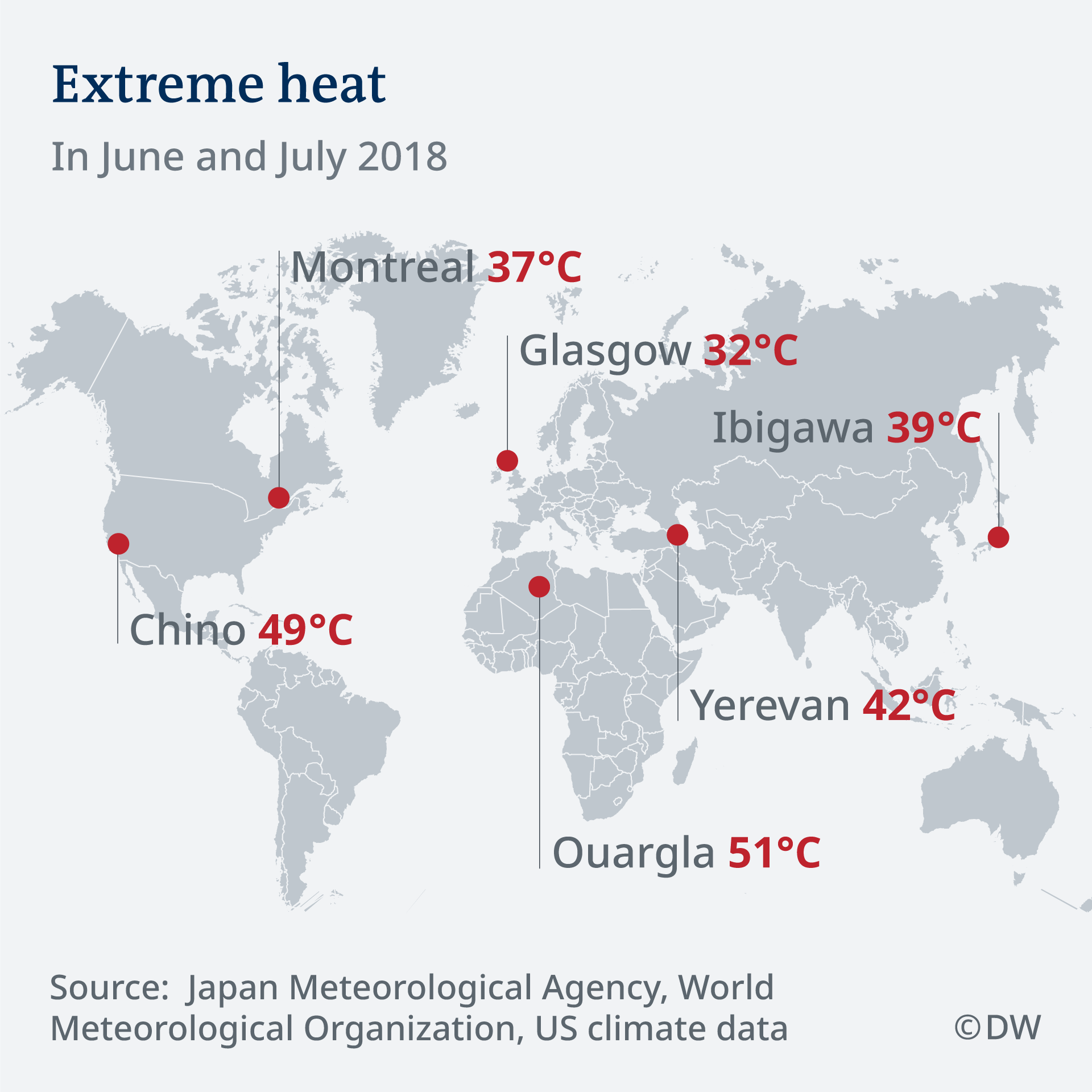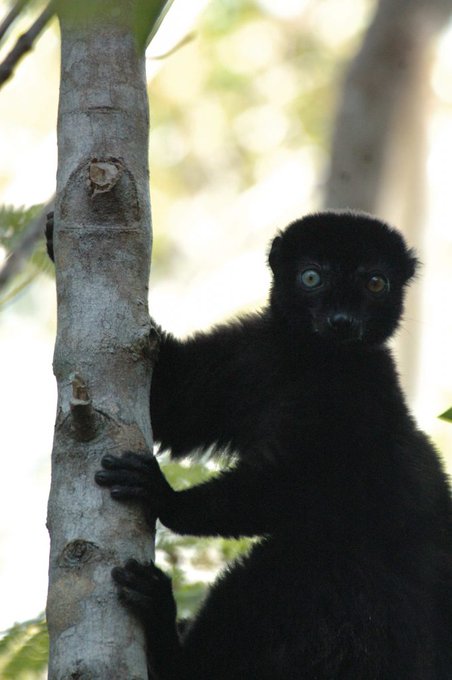mmmmm just sayin,for the record
TOP STORIES /
ENVIRONMENT
HEAT WAVE
Brace yourself for more record heat
Current high temperatures in the northern hemisphere are set to continue. Climate change means we're likely to experience very hot summers more often — even though we're already struggling with health consequences now.
![]()
Europe is in the throes of a
heat wave, and it's not letting up — on the contrary. More hot air is coming over from Africa, and is even bringing desert dust with it.
Southwestern European countries are being hit especially hard. Authorities in
Portugal issued a nationwide health warning, including for dust from the Sahara. Warnings were also issued for 40 of Spain's 50 provinces. The southeastern Portuguese town of Beja is expected to see a peak of 47 degrees Celsius (117 degrees Fahrenheit) on Saturday.
If people on the Iberian peninsula feel like they can't think clearly in that sort of heat anymore, that's not just subjective. Hot weather can make your thinking 13 percent slower, showed a study conducted by the Harvard Chan School of Public Health this past July.
But that's not the only problem with extreme heat. High temperatures increase the level of pollutants in the air, as they speed up the rate of chemical reactions. This increases the risk of cardiovascular and respiratory diseases.
On top of that, unusually high temperatures at night disturb
restful sleep, preventing the body from recovering from daytime heat.
Watch video01:44
Europe’s heat wave shows no signs of abating
"Heat waves have caused much higher fatalities in Europe in recent decades than any other extreme weather event," Vladimir Kendrovski, a WHO climate change officer for Europe pointed out.
Vulnerable groups such as young children and the elderly suffer the most. Many victims of extreme heat live in densely populated urban areas, which often suffer from a "heat-island effect," and where ventilation is scarce.
Read more: Current heat waves are linked to climate change, scientists confirm
Parts of Asia hard-hit
Japan is experiencing unprecedented high temperatures this summer.
At least
119 people died of heat stress in July, with 49,000 more being hospitalized. The city of Kumagaya set a new national heat record, with temperatures hitting 41.1 degrees Celsius (106 degrees Fahrenheit) in late July. In Tokyo, temperatures rose above 40 degrees Celsius (104 degrees Fahrenheit) for the first time ever.
Read more: Will extreme weather become even deadlier?
Watch video01:37
Japan swelters in record temperatures
China is set to experience significant problems with extreme heat in the not-too-distant future, according to a new study.
Researchers from the Massachusetts Institute of Technology (MIT) have shown that unless drastic measures are taken to limit greenhouse gas emissions, China's most populous and agriculturally important region could repeatedly face conditions in which humans cannot survive unprotected in the open for extended periods of time.
Human-caused climate change will also fuel more heat waves in the United States, researchers at the University of Miami Rosenstiel School of Marine and Atmospheric Science found.
Climate change will be a dominant driver for heat wave events in the Great Lakes region by 2030, and in the northern and southern plains by 2050 and 2070, respectively.
"Without human influence, half of the extreme heat waves projected to occur during this century wouldn't happen," said the report's lead author Hosmay Lopez.
In many places, the problem isn't just extreme heat, but heat coupled with humidity.
Heat ups risk for malaria
Hot, humid weather is also a perfect setting for insects to thrive. This is particularly worrisome for countries vulnerable to diseases such as malaria or dengue — that is, vector-borne diseases — transmitted by the bite of species such as mosquitoes, ticks or blackflies.
"Vector-borne diseases are associated with climate change, due to their widespread occurrence and the vectors' sensitivities to their environments," Kendrovski said.
Mosquitos like
Aedes aegypti, which can transmit dengue and yellow fever, are spreading into new regions due at least in part to rising temperatures.
Heat waves likely to get more lethal
So what can humans do to survive the heat? Don't stay in the sun, wear light, loose clothing, and drink enough water.
HOW CITIES AND PEOPLE CAN BEAT THE HEAT
Paint the town white
One easy way to combat the harsh summer sun could be painting your roof white — an idea long embraced by Greeks. A black roof absorbs most of the sunlight that hits it, heating up the underlying home like an oven. Light-colored surfaces, on the other hand, can reflect up to 80 percent of the sun's rays, keeping inside temperatures cooler. That also means a lower carbon footprint and energy bill.
1234567
Nausea and headaches are common reactions to the heat; but altered behavior, vomiting, rapid breathing and a racing heart could be signs of heatstroke. In that case, an ambulance should be called immediately. Untreated heatstroke can quickly damage your brain, heart, kidneys and muscles. The longer the treatment is delayed, the higher the risk of serious complications or death.
In the future, the number of fatalities as a result of heat waves is likely to rise if people are not able to adapt to rising temperatures.
Researchers from Australia's Monash University developed a model to estimate the number of deaths related to heatwaves in 20 countries for the period of 2031 to 2080. Under the most extreme scenario, there would be a 471 percent increase in deaths caused by heat waves in the Australian cities of Brisbane, Sydney and Melbourne in comparison with the period 1971 to 2010.
In good news, another recent study indicates that Spain has indeed been able to adapt to hotter temperatures. Although summer temperatures in Spain have risen by more than 1 degree Celsius since 1980 due to climate change, heat-related deaths have declined since then, researchers at the Barcelona Institute for Global Health found.
"Improvements in housing stock, the popularization of air conditioning, advances in health services, and awareness campaigns are all factors that may have contributed to the trend we are seeing," said senior author Joan Ballester.
"However, we still don't know whether this downward trend will continue if climate change becomes more intense in the future," he concluded.
SOARING TEMPERATURES, WILDFIRES SCORCH EUROPE
Europe strips off
Summer 2018 began as a welcome break from Europe's often-unpredictable weather, and people took advantage of the constantly warm temperatures to spend more time outside. The heat was especially a boon for pubs and bars where fans congregated to watch the soccer World Cup. But as temperatures climbed to up to 39 Celsius, the heat wave's negative effects began to be felt across the continent.
Brace yourself for more record heat | DW | 03.08.2018




















/https://public-media.smithsonianmag.com/filer/f4/73/f47305f7-9d6b-434b-ba9b-78521df5fdc3/rotstirnmaki_maennchen.jpg)























/https://public-media.smithsonianmag.com/filer/e4/c7/e4c73ef2-f1aa-43e5-874d-9442c3de5990/20180716-02melbabrown.jpg)



/https://public-media.smithsonianmag.com/filer/d6/df/d6dfca3e-4c02-425d-b082-5b2d7a77bc87/9049865251_fd2cf15a9a_b.jpg)


